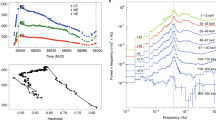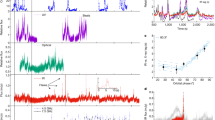Abstract
QUASIPERIODIC intensity oscillations with frequencies in the range 6–10 Hz have recently been discovered in luminous low-mass X-ray binary systems1,2. These so-called 'normal-branch' oscillations (NBOs) seem to be a nearly universal feature of those systems with luminosities near the Eddington critical luminosity LE (refs 3,4), at which the outward force of radiation balances gravity. Here we report the results of numerical simulations of the approximately radial accretion flow expected near the neutron-star component, which show that the flow becomes overstable (that is, the flow oscillates, with increasing magnitude) when the luminosity rises to within a few per cent of LE. If the radial inflow begins ∼300 km from the neutron star (as expected), the frequency of the oscillations is ∼5–10 Hz, comparable to the observed frequencies of NBOs. The time variation in optical depth is substantial, whereas the variation in luminosity is relatively small. The predicted amplitudes and phases of the resulting intensity oscillations agree with observations5 of the NBOs. We suggest that the 10–20 Hz oscillations in intensity observed in Scorpius X-l when it is on the flaring branch3,4 are caused by photohydrodynamic modes that are excited by the oscillations in the radial flow and grow when the luminosity exceeds LE.
This is a preview of subscription content, access via your institution
Access options
Subscribe to this journal
Receive 51 print issues and online access
$199.00 per year
only $3.90 per issue
Buy this article
- Purchase on Springer Link
- Instant access to full article PDF
Prices may be subject to local taxes which are calculated during checkout
Similar content being viewed by others
References
Middleditch, J. & Priedhorsky, W. C. Astrophys. J. 306, 230–237 (1986).
Norris, J. P. & Wood, K. S. Astrophys. J. 312, 732–738 (1987).
Lewin, W. H. G., van Paradijs, J. & van der Klis, M. Space Sci. Rev. 46, 273–377 (1988).
van der Klis, M. A. Rev. Astr. Astrophys. 27, 517–553 (1989).
Mitsuda, K. et al. Adv. Sp. Res. 8, 391–395 (1988).
Lamb, F. K. Adv. Sp. Res. 8, 421–447 (1988).
Hasinger, G., van der Klis, M., Ebisawa, K., Dotani, T. & Mitsuda, K. Astr. Astrophys. (submitted).
Alpar, M. A. & Shaham, J. Nature 316, 239–241 (1985).
Lamb, F. K., Shibazaki, N., Alpar, M. A. & Shaham, J. Nature 317, 681–687 (1985).
Shibazaki, N. & Lamb, F. K. Astrophys. J. 316, 767–785 (1987).
Lamb, F. K. Astrophys. J. (in the press).
Lamb, F. K. in Proc. 14th Texas Symp. on Relativistic Astrophys. (ed. Fenyves, E.) (New York Academy of Science, in the press).
Klein, R. I., Stockman, H. S. & Chevalier, R. A. Astrophys. J. 237, 912–930 (1980).
Burger, H. L. & Katz, J. I. Astrophys. J. 265, 393–401 (1983).
Miller, G. S. Astrophys. J. (submitted).
Spiegel, E. A. in Physique des Mouvements dans les Atmospheres Stellaires 19–50 (CNRS, Paris, 1976).
Author information
Authors and Affiliations
Rights and permissions
About this article
Cite this article
Fortner, B., Lamb, F. & Miller, G. Origin of 'normal-branch' quasiperiodic oscillations in low-mass X-ray binary systems. Nature 342, 775–777 (1989). https://doi.org/10.1038/342775a0
Received:
Accepted:
Issue Date:
DOI: https://doi.org/10.1038/342775a0
This article is cited by
-
Understanding the inner structure of accretion disk in GX 17+2: AstroSat’s outlook
Journal of Astrophysics and Astronomy (2021)
-
AstroSat/LAXPC view of GX 17+2: spectral evolution along the Z-track
Astrophysics and Space Science (2020)
-
The time lag spectrum of Cir X-1 on its normal branch
Science China Physics, Mechanics and Astronomy (2010)
-
Structure analysis of solution to equations of quasi 3-D accretion disk model
Science in China Series A: Mathematics (2001)
Comments
By submitting a comment you agree to abide by our Terms and Community Guidelines. If you find something abusive or that does not comply with our terms or guidelines please flag it as inappropriate.



